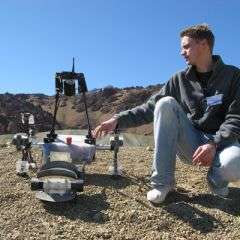ESA's Lunar Robotics Challenge: A tough task for the student teams

(PhysOrg.com) -- The Teide volcanic peak on the island of Tenerife acted as a mock-up of the Moon landscape last week, with eight European student teams tuning, testing and driving their lunar rovers in preparation for a robotics competition that took place during the dark nights of last weekend.
Roving on the Moon is not easy. Lunar robotic explorers have to travel in a vacuum, over rough and steep terrain covered by crust and dust. The Sun heats the rovers up to 110°C and, when driving into a shadow, the temperature can drop to -100°C, or almost -200°C in the polar regions. The rovers have to be remote-controlled or able to steer themselves autonomously, making manoeuvres and scientific research very difficult.
ESA's Lunar Robotics Challenge for university students makes roving a little bit easier, as the conditions on Teide at an altitude of 2000 metres are much more comfortable for the drivers and rovers alike. The terrain is still difficult - comparable to that found at the lunar poles - and operating the robotic vehicle in the dark, freezing cold of night with only the aid of radio links, cameras and sensors is challenging.
The student teams were pushed to the limits by the weather - of a type that is definitely not found on the Moon, such as clouds and rain - but also by technical issues. Finally, only one of the eight teams, from the University of Bremen, managed to accomplish the mission and two other teams were near to mission success.
Another challenge is faced now by Gianfranco Visentin, head of the Automation and Robotics Laboratory in ESA’s European Space Research and Technology Centre (ESTEC), who is one of the initiators of the challenge and leads the jury.
“We need some more time to count the points and penalties of each team, because the weather conditions forced us to change the competition timetable and the results are not directly comparable,” says Visentin. “It turned out to be a real challenge just like we wanted and also a competition between the teams. We chose Teide because we wanted to have tough conditions. And that's exactly what we got!”
Challenge for the students
ESA’s first Lunar Robotics Challenge was announced in late March, when European university students were invited to create an innovative, mobile robot capable of retrieving samples from a lunar-like crater. The vehicles were required to weigh no more than 100 kg, consume no more than 2 kW of power, and occupy a volume of no more than 0.5 cubic metres with deployable appendages stowed.
The robot’s test mission was designed to simulate a real lunar sample return mission. The rover had to be able to move from a ‘landing site’ to the rim of a lunar-like crater, descend to the bottom of the 15 m deep crater, locate and retrieve at least 0.1 kg of selected, visually distinctive, soil samples from the bottom of the crater and return to the ‘landing site’. When descending and climbing the rim of the crater the rover had to be capable of driving on slopes with an incline of up to 40 degrees.
The rover had to be remotely operated from a workstation located outside the crater, from where there was no direct visibility of the crater or its rim. And all this had to be done in light which cast very long shadows at the rim and total darkness in the crater
Student teams from all over Europe submitted proposals to ESA during the months after the announcement of opportunity, and from these, eight teams were selected. They were asked to design their robotic systems to be presented in a Critical Design Review last July. Finally, after successfully completing a Test Readiness Review, the teams constructed their robots for the final challenge event. Their work was supported by funding from the ESA General Studies Programme.
The challenge culminated last week, when the eight selected teams gathered in Tenerife with their robots.
“Although we had only one group accomplish the mission, I think everybody won here,” states Gianfranco Visentin. “The teams came with great ideas, they realised them in an incredibly short time and show that you can actually solve a difficult technical problem. From the education point of view, we wanted these young engineers to be motivated and learn about space robotics and to do something practical with it, and this is a full success.”
The final results will be announced shortly.
Provided by ESA





















